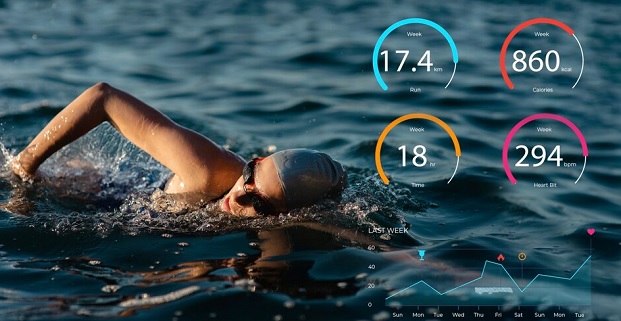Swimming is a great weight loss activity and a relaxing summer pastime. It is a low impact full body exercise that may assist you in losing weight and performing your fitness objectives. This post will explain the best weight loss swimming program and how to enhance results.
Interval Training
Interval exercise is an excellent technique for burning calories and enhancing metabolism. This method alternates high intensity swimming with rest or reduced intensity. Pushing yourself during intensive intervals raises your heart rate and burns calories while recovery times let you regain your breath and swim longer.
Interval training often involves swimming multiple laps at a fast speed followed by a short break. For example swim four laps quickly then one or two laps slowly to recuperate. Continue this cycle for a defined time increasing the intensity or length of high intensity intervals as you become fitter.
Due to the afterburn effect, interval training burns calories during and after exercise. This means your body consumes more oxygen to recover its pre exercise condition increasing calorie expenditure after swimming.
Strength Training In The Water
Strength training while swimming may boost weight reduction by strengthening lean muscular mass and strength. Water resistance makes typical strength workouts harder and can tone and sculpt muscles while burning calories. Water resistance devices like aqua dumbbells or resistance bands may help you strengthen while swimming.
These gadgets are helpful for arm, leg and core workouts. You can execute bicep curls, tricep extensions, leg lifts and body twists while treading or swimming. Swimming works the shoulders, back , chest , arms and legs making it a great full body exercise. Swimming and strength training boost calorie burn muscular definition and fitness.
Consistency And Progression
Any training plan for weight reduction requires persistence. For long term outcomes swim three to five times a week. Consistency helps increase endurance, improve technique, burn calories and reach weight reduction objectives.
It would help if you also pushed yourself as you become fitter and more robust. This might entail increasing the length or intensity of your swims attempting new strokes or techniques or establishing objectives like swimming a particular distance or laps at a specific time.
Tracking your progress may encourage and hold you responsible. Record your workouts’ distance duration and other parameters. Celebrate milestones like swimming further or setting a new personal best.
An organized swimming practice that includes interval training, strength workouts and constant effort may help you lose weight and improve your fitness and health. Grab your swimwear and jump in. Your fitness journey begins in the pool
Variety And Cross Training
Variety in your weight reduction regimen helps avoid boredom and plateaus and challenges your body in new ways. Swimming is a great activity. Try freestyle breaststroke backstroke and butterfly to target various muscle areas and spice up your training.
Variate your strokes and cross train with various exercises to complement your swimming regimen. Cycling, jogging and strength training on land may boost cardiovascular health and prevent overuse by resting your muscles from swimming.
Cross training improves swimming performance and weight reduction by improving agility, flexibility and muscular endurance. Yoga and Pilates help enhance core strength and flexibility which are crucial for swimming form. Variety and cross training make sessions enjoyable and challenge your body resulting in more excellent outcomes and a more balanced fitness program.
Nutrition And Hydration
Swimming is vital for weight reduction but you must eat well and stay hydrated. Fruits, lean meats, vegetables and whole grains fuel your exercises and promote muscle repair and development. Protein helps build and repair muscle which supports metabolism and fat burning making it ideal for weight reduction.
Include protein rich chicken, fish , tofu beans and nuts in your daily meals and snacks. Hydration is vital for optimal performance and weight reduction. Drink lots of water before, during and after swimming to stay hydrated and energized.
Electrolytes including sodium potassium and magnesium help replace fluids and sustain muscle function together with water. Try electrolyte rich beverages or snacks to restore electrolyte balance and hydration after swimming. You may lose weight, swim and feel better by paying attention to your diet and hydration.
Rest And Recovery
Despite the temptation to push yourself to lose weight, relaxation and healing are essential to prevent burnout and injury. Swimming strains your muscles and joints so resting and repairing is crucial for long term performance. To restore your muscles between training include rest days in your swimming schedule.
Take a day off from swimming or do low impact exercises like walking stretching or moderate yoga to improve circulation and flexibility.
To heal and function well emphasize excellent sleep and rest days. Sleep seven to nine hours every night and create a calm evening ritual to unwind and prepare for sleep.
If you feel pain or discomfort during swimming, listen to your body and take action. This may require changing your technique using goggles or swim caps or seeing a swimming coach or physical therapist. Rest and rehabilitation help prevent injuries, fatigue and inconsistent swimming which improves weight loss and fitness.
Setting Realistic Goals
Create reasonable objectives to stay motivated and on track when swimming for weight reduction. Instead of concentrating on the scale establish swimming performance objectives like increasing your distance speed endurance or stroke.
Breaking significant objectives into smaller milestones might help you remain focused and make them seem more achievable. For example if you want to swim a mile without stopping start with shorter lengths and increase them over time.
Consider creating process oriented swimming objectives in addition to performance based goals. You may commit to several weekly swim sessions including strength or interval training routines or prioritize good nutrition and hydration to support your efforts.
Setting realistic and achievable objectives can help you remain motivated and responsible, celebrate your successes and achieve long term success in and out of the pool.
Mindful Swimming
Swimming offers mindfulness and stress relief in addition to physical advantages. Its rhythm and water feel may alleviate tension and promote relaxation.
To practice mindfulness while swimming concentrate on the water feel against your skin, your breath and your body movement. Awareness and presence improve your swimming experience and mental and emotional health.
Conclusion
Swimming is an excellent technique for losing weight and improving fitness and well being. An organized swimming regimen with interval training, strength training and consistency maximizes calorie burn and yields long term effects.
Variety nutrition, hydration and mindfulness may improve your swimming experience and weight reduction. Set achievable objectives emphasize rest and recovery and seek expert help to achieve safe and sustainable growth. Start swimming, remain dedicated and enjoy its numerous advantages on your way to a healthier fitter.




